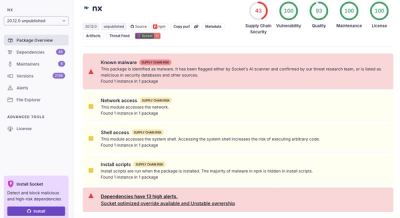
Security News
Risky Biz Podcast: Making Reachability Analysis Work in Real-World Codebases
This episode explores the hard problem of reachability analysis, from static analysis limits to handling dynamic languages and massive dependency trees.
cellx-collections
Advanced tools
If you record to the cell an instance of class which inherits of `cellx.EventEmitter`, then the cell will subscribe to its `change` event and will claim it as own:
If you record to the cell an instance of class which inherits of cellx.EventEmitter,
then the cell will subscribe to its change event and will claim it as own:
let value = cellx(new cellx.EventEmitter());
value.subscribe((err, evt) => {
console.log(evt.target instanceof cellx.EventEmitter);
});
value().emit('change');
// => true
Due to this, you can create your collections, upon updating those collections you will update the cell containing them and dependent cells will be recalculated. Two such collections already is added to the cellx:
Example:
let map = new cellx.ObservableMap({
key1: 1,
key2: 2,
key3: 3
});
cellx.ObservableMap repeats
Map from ECMAScript 2015,
except for the following differences:
cellx.EventEmitter and generates an event change when changing their records;clone, which creates a copy of map;Example:
let list = new cellx.ObservableList([1, 2, 3]);
Like cellx.ObservableMap, list generates an event change upon any change of its records.
During initialization the list may take option itemComparator, which will implement the assortment of its items:
let list = new cellx.ObservableList([
{ x: 5 },
{ x: 1 },
{ x: 10 }
], {
itemComparator: (a, b) => {
if (a.x < b.x) { return -1; }
if (a.x > b.x) { return 1; }
return 0;
}
});
console.log(list.toArray());
// => [{ x: 1 }, { x: 5 }, { x: 10 }]
list.addRange([{ x: 100 }, { x: -100 }, { x: 7 }]);
console.log(list.toArray());
// => [{ x: -100 }, { x: 1 }, { x: 5 }, { x: 7 }, { x: 10 }, { x: 100 }]
If instead of itemComparator you pass the option sorted with the value true, it will use the standard itemComparator:
let list = new cellx.ObservableList([5, 1, 10], { sorted: true });
console.log(list.toArray());
// => [1, 5, 10]
list.addRange([100, -100, 7]);
console.log(list.toArray());
// => [-100, 1, 5, 7, 10, 100]
Length of the list. Read-only.
Function for comparing items in the sorted list. Read-only.
Whether or not the list is sorted. Read-only.
Important difference between list and array is that the list can't contain so-called "holes"
that is, when it will try to read or set the item of the index beyond the existing range of indexes,
an exception will be generated.
Range extension (adding of items) occurs through methods add, addRange, insert and insertRange.
In such case, in the last two methods passed index can not be longer than the length of the list.
Sorted list suggests that its items are always in sorted order. Methods
set, setRange, insert and insertRange are contrary to this statement, they either will break the correct order
of sorting or (for preservation of this order) will install/paste past the specified index, i.e.
will not work properly. Therefore, when you call the sorted list, they always generate an exception. It is possible to
add items to the sorted list through the methods add and addRange, or during initialization of the list.
Type signature: (item) -> boolean;.
Checks if the item is in the list.
Type signature: (item, fromIndex?: int) -> int;.
Type signature: (item, fromIndex?: int) -> int;.
Type signature: (index: int) -> *;.
Type signature: (index: int, count?: uint) -> Array;.
If count is unspecified it makes copies till the end of the list.
Type signature: (index: int, item) -> cellx.ObservableList;.
Type signature: (index: int, items: Array) -> cellx.ObservableList;.
Type signature: (item, unique?: boolean) -> cellx.ObservableList;.
Type signature: (items: Array, uniques?: boolean) -> cellx.ObservableList;.
Type signature: (index: int, item) -> cellx.ObservableList;.
Type signature: (index: int, items: Array) -> cellx.ObservableList;.
Type signature: (item, fromIndex?: int) -> boolean;.
Removes the first occurrence of item in the list.
Type signature: (item, fromIndex?: int) -> boolean;.
It removes all occurrences of item list.
Type signature: (index: int) -> *;.
Type signature: (index: int, count?: uint) -> Array;.
If count is unspecified it will remove everything till the end of the list.
Type signature: (oldItem, newItem, fromIndex?: int) -> boolean;.
Type signature: (oldItem, newItem, fromIndex?: int) -> boolean;.
Type signature: () -> cellx.ObservableList;.
Type signature: (separator?: string) -> string;.
Type signature: (cb: (item, index: uint, list: cellx.ObservableList), context?);.
Type signature: (cb: (item, index: uint, list: cellx.ObservableList) -> *, context?) -> Array;.
Type signature: (cb: (item, index: uint, list: cellx.ObservableList) -> ?boolean, context?) -> Array;.
Type signature: (cb: (item, index: uint, list: cellx.ObservableList) -> ?boolean, context?) -> boolean;.
Type signature: (cb: (item, index: uint, list: cellx.ObservableList) -> ?boolean, context?) -> boolean;.
Type signature: (cb: (accumulator, item, index: uint, list: cellx.ObservableList) -> *, initialValue?) -> *;.
Type signature: (cb: (accumulator, item, index: uint, list: cellx.ObservableList) -> *, initialValue?) -> *;.
Type signature: (cb: (item, index: uint, list: cellx.ObservableList) -> ?boolean, fromIndex?: int) -> *;.
Type signature: (cb: (item, index: uint, list: cellx.ObservableList) -> ?boolean, fromIndex?: int) -> *;.
Type signature: (cb: (item, index: uint, list: cellx.ObservableList) -> ?boolean, fromIndex?: int) -> int;.
Type signature: (cb: (item, index: uint, list: cellx.ObservableList) -> ?boolean, fromIndex?: int) -> int;.
Type signature: () -> cellx.ObservableList;.
Type signature: () -> Array;.
Type signature: () -> string;.
FAQs
If you record to the cell an instance of class which inherits of `cellx.EventEmitter`, then the cell will subscribe to its `change` event and will claim it as own:
The npm package cellx-collections receives a total of 4 weekly downloads. As such, cellx-collections popularity was classified as not popular.
We found that cellx-collections demonstrated a not healthy version release cadence and project activity because the last version was released a year ago. It has 1 open source maintainer collaborating on the project.
Did you know?

Socket for GitHub automatically highlights issues in each pull request and monitors the health of all your open source dependencies. Discover the contents of your packages and block harmful activity before you install or update your dependencies.

Security News
This episode explores the hard problem of reachability analysis, from static analysis limits to handling dynamic languages and massive dependency trees.

Security News
/Research
Malicious Nx npm versions stole secrets and wallet info using AI CLI tools; Socket’s AI scanner detected the supply chain attack and flagged the malware.

Security News
CISA’s 2025 draft SBOM guidance adds new fields like hashes, licenses, and tool metadata to make software inventories more actionable.